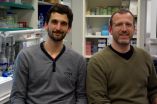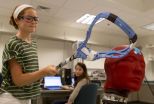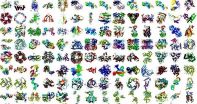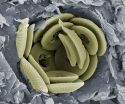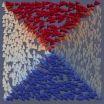Researchers design a model to predict the effects of chemical substances on health
The analysis of drugs, natural products, and chemical substances found in the environment allows the identification of the chemical fragments responsible for a therapeutic or deleterious effect on human health
2014-12-01
(Press-News.org) Current data bases hold information on thousands of molecules--including drugs, natural substances, and chemical agents found in the environment-- that are associated with diseases, either because they have adverse effects or exert a therapeutic action. Using this information, gathered over many years and available in data bases, scientists headed by ICREA researcher Patrick Aloy at the Institute for Research in Biomedicine (IRB Barcelona) have devised a predictive model that allows them to associate chemical fragments with positive or negative effects in 20% of human diseases. Published today in Nature Communications, the study may have applications for the design of safer drugs, the detection of comorbidity, and the extension of current drug uses.
The study has involved the analysis of 10,000 chemical molecules, which together comprise 98,077 fragments associated with 1,176 diseases--these representative of all human diseases.
Pharmacology prior to the '80s seen from the 21st century
Until the '80s, pharmacologists designed a chemical substance and studied its effect on a model organism. Without examining the impact of these substances at the molecular level or the proteins that they altered, these scientists developed many drugs for a wide range of diseases. This system of trial and error, which produced a large body of information, was abandoned with the advent of molecular biology. Since the beginning of the 21st century, drugs have been designed to alter the behaviour of proteins or genes that have previously been identified as being affected in certain diseases. Based on prior knowledge of biology, this approach is not producing the results expected.
The chemist Miquel Duran, a PhD student working on network biology at IRB Barcelona, questioned whether the accumulation of current data that associate the chemical structure of substances with disease through its therapeutic or deleterious effect would allow the development of a predictive model that related the chemical structure of a compound with its effect in humans. "In effect, we have enough information on chemical structures to reasonably predict their effects in 20% of human diseases," explains Duran. "This implies the data on chemical structures, which on many occasions and above all in the field of molecular biology is not taken into account, can be most useful for biomedicine, for example for the design of safer drugs," says the researcher. The study allows the information accumulated to be re-examined and reorganised and to produce 20% of new knowledge thanks to the exploitation of computerized data.
The design of safer drugs, prediction of disease co-morbidities and repositioning of drugs
Patrick Aloy explains that the study allows access to valuable information that can serve to avoid or foster the use of certain chemical fragments for drug design. For example, his model predicts that 40% of chemical fragments with therapeutic effects are not included in drugs currently on the market; in contrast, fragments that cause secondary effects are.
The researchers also indicate that their study may serve to detect associations between two diseases, the so-called co-morbidity--meaning one leads to the development of the other-- or inverse comorbidity--namely that one protects against the development of the other. The study may also reveal potential new uses of current drugs.
INFORMATION:
This study, conducted by the Structural Bioinformatics and Network Biology lab headed by Patrick Aloy, has been supported by the Ministry of Economy and Competitiveness, the European Commission, and the European Research Council.
Reference article:
A chemo-centric view of human health and disease
Miquel Duran-Frigola, David Rossell & Patrick Aloy
Nature Communications (1 December 2014) doi: 10.1038/ncomms6676
ELSE PRESS RELEASES FROM THIS DATE:
2014-12-01
Athens, Ga. - Debunking the myth of the "mean girl," new research from the University of Georgia has found that boys use relational aggression--malicious rumors, social exclusion and rejection--to harm or manipulate others more often than girls.
The longitudinal study, published online in the journal Aggressive Behavior, followed a cohort of students from middle to high school and found that, at every grade level, boys engaged in relationally aggressive behavior more often than girls.
A team led by UGA professor Pamela Orpinas analyzed data collected from 620 students ...
2014-12-01
PROVIDENCE, R.I. [Brown University] -- Lacrosse players swing hard, which is why errant stick blows are the leading cause of concussion in girls' and women's lacrosse. In a new study, researchers measured how much the worst blows accelerate the head and how much different kinds of headgear could reduce those accelerations.
Girls' and women's lacrosse is a different game from the version played by males, said Joseph Crisco, the Henry Frederick Lippitt Professor of Orthopaedic Research in the Alpert Medical School of Brown University and a researcher at Rhode Island Hospital. ...
2014-12-01
A DRUG that could reduce the harmful side-effects of 'binge drinking', especially by teenagers, has been successfully developed and tested by a team of European scientists, including the University of Huddersfield's Professor Mike Page and Dr Karl Hemming. There is also the potential for new ways to treat Alzheimer's and other neurological diseases that damage the brain.
The key to the breakthrough is a compound developed by Professor Page and colleagues at the University of Huddersfield which is named ethane-beta-sultam. This is a taurine 'pro-drug' - an effective ...
2014-12-01
Knowledge of the three-dimensional structures of proteins is essential for understanding biological processes.
Structures help to explain molecular and biochemical functions, visualize details of macromolecular interactions, facilitate understanding of underlying biochemical mechanisms and define biological concepts.
The human genome and follow-up sequencing projects have revolutionized biology and medicine; structural genomic programmes have developed and applied structure-determination pipelines to a wide range of protein targets, facilitating the visualization of ...
2014-12-01
A study of ancient marine algae, led by the University of Southampton, has found that climate change affected their growth and skeleton structure, which has potential significance for today's equivalent microscopic organisms that play an important role in the world's oceans.
Coccolithophores, a type of marine algae, are prolific in the ocean today and have been for millions of years. These single-celled plankton produce calcite skeletons that are preserved in seafloor sediments after death. Although coccolithophores are microscopic, their abundance makes them key contributors ...
2014-12-01
"A quantum computer may be thought of as a 'simulator of overall Nature," explains Fabio Franchini, a researcher at the International School for Advanced Studies (SISSA) of Trieste, "in other words, it's a machine capable of simulating Nature as a quantum system, something that classical computers cannot do". Quantum computers are machines that carry out operations by exploiting the phenomena of quantum mechanics, and they are capable of performing different functions from those of current computers. This science is still very young and the systems produced to date are ...
2014-12-01
Subliminal visual cues are words, pictures or symbols which are unidentifiable in someone's conscious.
Conducted by Professor Samuele Marcora in collaboration with colleagues at Bangor University, the research discovered that athletes undergoing endurance exercise who were presented with positive subliminal cues, such as action-related words, including 'go' and 'energy', or were shown happy faces, were able to exercise significantly longer compared to those who were shown sad faces or inaction words.
The words and faces appeared on a digital screen - placed in front ...
2014-12-01
Researchers at DESY have used high-speed photography to film one of the candidates for the magnetic data storage devices of the future in action. The film was taken using an X-ray microscope and shows magnetic vortices being formed in ultrafast memory cells. Their work, which has been reported by the scientists surrounding Dr. Philipp Wessels of the University of Hamburg in the journal Physical Review B, provides a better understanding of the dynamics of magnetic storage materials. Magnetic memory cells are found in every computer hard drive.
"Our images allow us to observe ...
2014-12-01
Group mindfulness treatment is as effective as individual cognitive behavioural therapy (CBT) in patients with depression and anxiety, according to a new study from Lund University in Sweden and Region Skåne. This is the first randomised study to compare group mindfulness treatment and individual cognitive behavioural therapy in patients with depression and anxiety in primary health care.
The researchers, led by Professor Jan Sundquist, ran the study at 16 primary health care centres in Skåne, a county in southern Sweden. They trained two mindfulness instructors, ...
2014-12-01
27 November 2014 - Anopheles mosquitoes are responsible for transmitting human malaria parasites that cause an estimated 200 million cases and more than 600 thousand deaths each year. However, of the almost 500 different Anopheles species, only a few dozen can carry the parasite and only a handful of species are responsible for the vast majority of transmissions. To investigate the genetic differences between the deadly parasite-transmitting species and their harmless (but still annoying) cousins, an international team of scientists, including researchers from the University ...
LAST 30 PRESS RELEASES:
[Press-News.org] Researchers design a model to predict the effects of chemical substances on health
The analysis of drugs, natural products, and chemical substances found in the environment allows the identification of the chemical fragments responsible for a therapeutic or deleterious effect on human health


